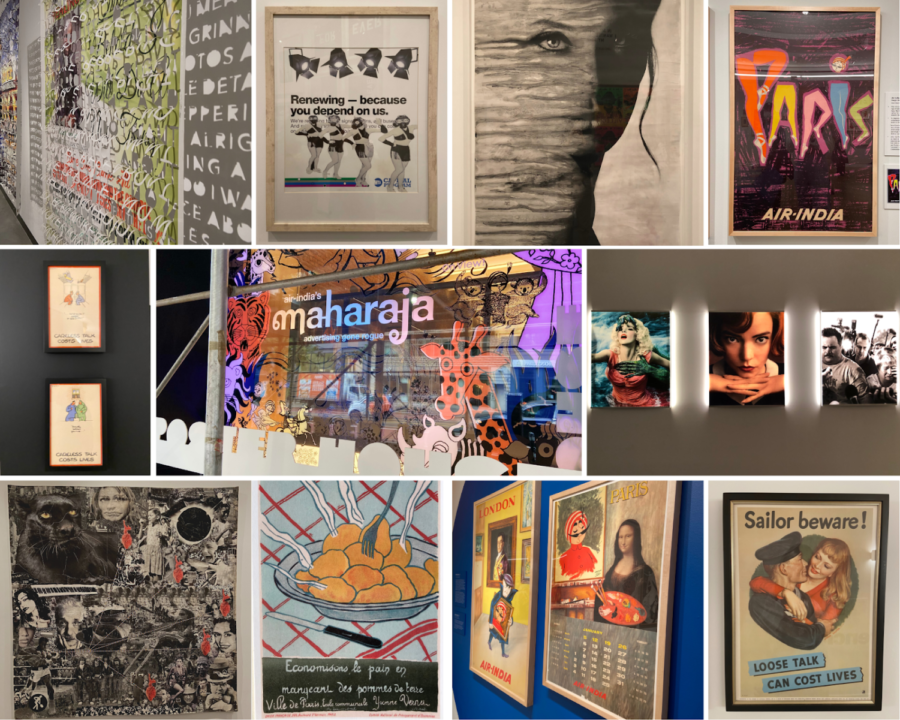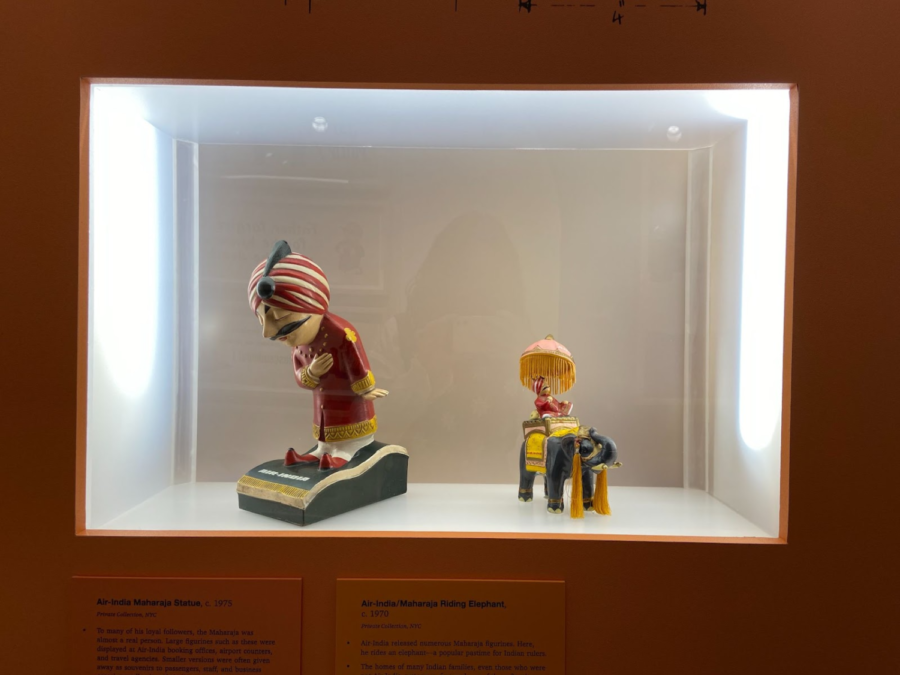From Rogue Artists to Questionable Mascots: How Poster House Reimagines Art
Having opened its doors in 2019, Poster House breaks the elitist mold through an inquiry into historical narratives and an exploration of the eccentric.
In this collage displaying various pieces at Poster House, the expert artistic expression emphasizes the museum’s eccentric exhibits.
You’re walking down an ordinary street in Chelsea, New York, passing the TD bank and ViVi Bubble Tea, when a message on a building facade catches your eye: “In a society that profits from your self-doubt, liking yourself is a rebellious act.” This quote by artist Caroline Caldwell is boldly plastered on the front door of the Poster House museum. Next to this powerful statement lie two other unique pieces. Seldom does a museum facade show an artwork of a melting face of Angelina Jolie in black-and-white in its glass window display, nor do acclaimed museum entrances present a group of neon-colored jungle animals. Poster House seeks to embrace art’s impact upon society through posters, covering everything from intriguing propaganda to renewed creative conventions.
Poster House was founded in 2015 by Val Crosswhite, who set her sights on spreading the art form of posters to broad audiences. The museum’s mission introduces audiences to a space that displays a multitude of unique creations, many of which prove art’s ability to contribute to a social campaign.
The museum is home to many educators that teach patrons about the rich content that Poster House offers. Es-pranza Humphrey, Education Programs Coordinator at Poster House, leads their Teen Programs at the museum. PH x Teens invites teenagers to a more in-depth lesson and behind-the-scenes look at posters on view. For Humphrey, working as a curator combines her original aspirations to be both a high school teacher and a curator. “As a museum educator, I was able to continue my passion for teaching, interacting with teens, and researching,” she said.
The educators also go beyond surface-level facts about the artwork by intertwining each piece’s context. “We understand slices of history and society by focusing our attention on posters and the circumstances surrounding their design and production,” said Maya Varadaraj, a lead educator at Poster House.
Modern art is a complex and exciting scene composed of talented people finding new meaning in old work. In this age, new artists throw away convention to reconfigure classic works and advertisements with a novel meaning. The current leading exhibit – entitled ‘Masked Vigilantes on Silent Motorbikes’– does just that.
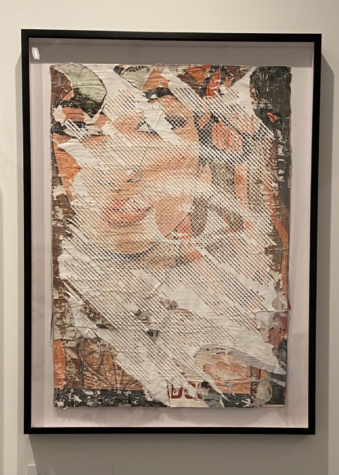
Vhils, whose work is showcased in the exhibit, highlights deconstruction in the piece Allusion. Created in 2019, Vhils rips apart an original cartoon poster and plasters a laser-engraved, paper eye on top. Rather than make a direct commentary on the original work, Vhils uses the piece as a metaphor for the ever-changing landscape of billboards and advertisements that riddle society today. In a reaction against this overstimulation, the poster denounces the trend. “The opportunities are endless, as anything from a small design to a large-scale sculpture or painting can easily become a widespread symbol of protest,” said Elizabeth Colón ’23 after her visit to the museum; the layering of these contrasting images communicates this greater plea.
Now, imagine you’re on Fifth Avenue and come across a dilapidated phone booth. Plastered on the sides are urging one to “come contour your love handles.” Enter Caroline Caldwell. Although Poster House is a museum dedicated to the art of posters, Caldwell’s unique installation sets itself apart from the wall-mounted pieces. The spray-painted, self-affirming phrases – “NO BAD DAYS” and “Grab The Wheel, Hit The Gas, Live Your Life, Hard n’ Fast” – replace the sides of the phone booth. Caldwell masterfully reimagines the piece to convey a body-positive message.
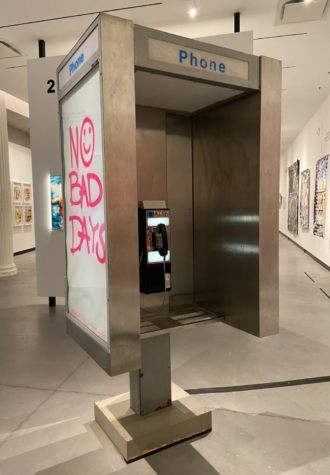
Another one of Poster House’s specialties resides in its exhibitions depicting propaganda posters throughout history. The top floor contains a small collection – ‘Schoolgirls at War: French Propaganda Posters from World War I.’ In a unique turn of events in a patriarchal France, the French government turned to young Persian schoolgirls to create World War I propaganda. While women’s roles were restricted to the domestic sphere, this small opportunity marked an unexpected shift towards female representation in the French art landscape. Focused on themes of preserving rations, many of the girls came up with phrases to inform the public, such as, “Réservez le vin pour nos poilus” [Save the wine for our soldiers] or “Ne pas gaspiller le pain est notre devoir” [It’s our duty not to waste bread].
While those posters command audiences, others give a personal angle. One notable piece in this call to action is entitled NOUS SAURONS. Created in 1918 by Camille Boutet, this poster offers a glimpse into the everyday challenges of war. In her creation, three children longingly gaze into the storefront of a candy store; to accompany this, Boutet captions, “Nous saurons nous en priver” [We know how to deprive ourselves]. In lieu of a rallying call for preservation, this artist had a melancholy interpretation of the deficiencies in her time.
“The intention is for viewers to stop and read about each piece’s rich history,” said Colón. “Learning is a central focus, rather than solely an appreciation for the way the pieces look.” The lens of a young, female artist conveyed sorrow felt by her generation, a voice often hidden from the public sphere. Nevertheless, this compact exhibition seeks to explore these untold perspectives. “Propaganda posters help us understand how multiple entities were involved in supporting historical events,” said Humphrey.
In addition to the current showings, past exhibits adaptly illustrate the unique ability of Poster House to explore diversity and possibilities in creative spaces. “The first show I saw at Poster House was ‘Baptized by Beefcake’ and I was so impressed with how the museum had brought such a niche grouping of posters to view,” said Varadaraj. The exhibit explored religion and Western media’s influence on advertising posters in Ghana: this intersection of spirituality and pop culture gave a look into how international advertising sought to mystify. The museum also highlighted enigmatic graphic designer Ethel Reed in her own exhibit — ‘Ethel Reed: I Am My Own Property.’ Audiences went on a journey of her work and changing style throughout the constant ebb and flow of her life. Rather than a mere famous name plastered onto the showcase, her exciting yet tragic life was explained alongside her posters. “Learning about Reed’s background and her entire life really enhanced the experience and made the exhibit even more memorable to me,” said Colón.
The other primary exhibit presently on view in the basement of Poster House is an unusual one: ‘Air-India’s Maharaja: Advertising Gone Rogue.’ With such a striking title, it’s easy to question this airline company’s nature of advertisements. Taken from Air-India’s “golden age of advertising,” the showcase displays the multitude of graphic design obscurities used in the mid-twentieth century to attract travelers. The subject of these advertisements is the Maharaja – meaning prince in Hindi – characterized by his signature round figure and handlebar mustache. The Maharaja takes various forms of disguise, from a tanned lifeguard in Sydney to a bunny living in New York.
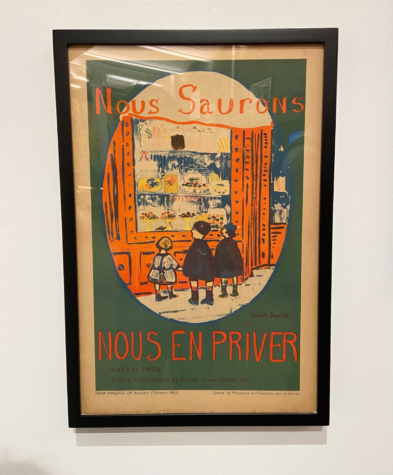
(Tammy Lam)
Air-India’s advertising plan commonly took familiar designs to appeal to international viewers. The American advertisement I Want You to Fly Air-India displays the iconic caricature: Uncle Sam. In Paris’s Air-India Calendar, the Maharaja became the Mona Lisa. In a separate French campaign, the Maharaja floats above the legs of the iconic Parisian cabaret dancers. While some of the public thought Air-India’s comical homage to noteworthy personalities was insulting, the Maharaja was not only a parody for airplane advertising. In a turn of events, Air-India used his likeness to make public service campaigns.
While American audiences are aware of iconic characters like Smokey Bear or Woodsy Owl, Poster House’s spotlight on Air-India’s wildlife protection and anti-smoking messages introduces audiences to the heart of the Maharaja. With the campaign’s wide range of contributing artists and adoring viewers, the Maharaja mascot has touched lives worldwide. Displayed on the wall of the exhibit is an idealistic quote from Air-India’s publicity manager Jal B. Cowasji: “The gallery will never be complete. The Maharaja will go on taking liberties, he will impersonate and be sentenced to a life-term— of love.”
Taking a look into a more traditional propaganda poster, the exhibit ‘With My Little Eye: Warnings For The Homefront’ transports viewers around the world through the lens of Allied Forces during World War II. Despite rallying for the same cause, each country employed varying styles of propaganda.
The U.K., in many ways, took a humorous approach to spread the message. In the series Careless Talk Cost Lives, various leaders of the Nazi Party, including multiple cartoon Hitlers and a corpulent Hermann Göring, overhear British citizens. Viewers can understand the separate goals of each country and the national culture and humor. “The Poster House delved deep into the history behind the period of each of their exhibitions, making the significance of each piece clear to the viewer,” said Colón.
The American works often used misogynistic language to blame women for gossip and “loose tongues,” in hopes of discouraging others and enforcing a society of obedience. Walking through the small hall, poster after poster gives warning signs to prevent the spread of men’s secrets: WANTED FOR MURDER, shows a portrait of a smirking woman with the caption “Her careless talk costs lives.” In today’s age, the stigma of gossip greatly contributes to modern society’s understanding of likely targets further revealed by posters, a keen example of Poster House’s aim in giving space for greater discovery of public persuasion of the past.
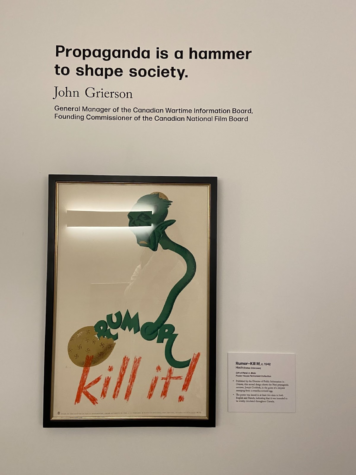
Rumor — Kill It! displays Joseph Goebbels, chief Nazi propagandist, emerging as a serpent from a Swastika-littered egg. The exhibition’s inclusion of this Canadian piece points to the emphasis of symbolism to inform the public. “Kill it!” in bold red. “Rumor” twisted into the body of the serpent. The striking expression of Goebbels plastered onto the white background. Posters like these clearly define the Nazi leaders the country villainizes. “They add an extra layer of understanding to the tone of the world because we get a sense of what people feared, who people looked to for answers, and what was prioritized in that time,” said Humphrey. The government’s intentions for propaganda send this clear message against the spread of lies by enemy spies, inciting fear of the possible repercussions. Even with all these interpretations across each country, the message still stands clear: in the midst of a “spy fever,” do not take the risk of betrayal.
Unlike various other traditional art museums, Poster House brings about creativity from often hidden perspectives in all its exhibits. “Art and museums in particular are often seen as elitist and/or inaccessible to the general public… It should be the mission of all those who engage in art to highlight the work of marginalized groups of people because they represent some of the most creative voices in this sphere,” said Humphrey. Poster House’s goal is to bring to light the importance of these rare pieces and weave historically accurate narratives for modern society to learn from. With a wide range of diverse works of art that highlight various aspects of the art world, past and present, Poster House is a unique art experience worth visiting. As Varadaraj said, “The museum consistently brings diverse and unknown design into light and that is why I work here.”
Maya Varadaraj, a lead educator at Poster House, said, “We understand slices of history and society by focusing our attention on posters and the circumstances surrounding their design and production.”
Tammy Lam is an Arts & Entertainment Editor for ‘The Science Survey.’ She believes that journalistic writing is important for enabling truths that...

